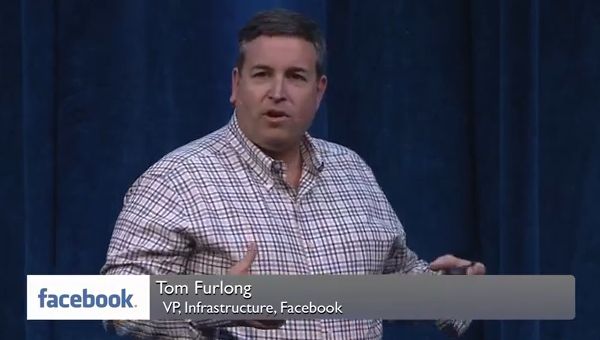 NEWS
NEWS
 NEWS
NEWS
 NEWS
NEWS
![]() Continuing the journey into Open Compute’s application in real life and the business environment, another Facebook executive, Tom Furlong (VP of Infrastructure Data Centers), took the stage at Open Compute Summit in San Jose, California, for a quick “Update on Facebook’s DCIM Solution“.
Continuing the journey into Open Compute’s application in real life and the business environment, another Facebook executive, Tom Furlong (VP of Infrastructure Data Centers), took the stage at Open Compute Summit in San Jose, California, for a quick “Update on Facebook’s DCIM Solution“.
Furlong reiterated that “Open Compute is changing the world,” and confessed that tweaking solutions for the DCIM represents one of his most recent passions.
Tom Furlong chose not to talk about software, hardware and data center as these topics were already covered in-depth by Jay Parikh’s presentation.
However, efficiency represents one of the most important issues in a company, and for Facebook that was like trying to solve a puzzle containing exactly these pieces: software, hardware and data center.
“At Facebook we’ve done a lot of work aligning the capabilities of hardware with the needs of the software. But today I’m going to talk about aligning the hardware to the data center,” said Furlong.
How do you put as much hardware into the data center as you can, and have it within a reasonable level of risk tollerance?
You are basically looking at several things:
.
1) The capacity, which is fixed in the data center (you have a certain amount of electrical capacity in the system itself).
2) The workload – for us the workload looks rather sinusoidal: we have peaks of the day and we have peaks of the week and essentially an updown workload. There’s also a region failure procedure- if a region has problems, the traffic will be diverted to another region.
3) Room for growth – when we launch products we don’t always know what we’re going to need. If the user adoption is faster than we anticipate, we may have to add hardware. We provision for growth.
.
Referencing the popular novel-turned trilogy Lord of Rings, Furlong stated that “we need a system to rule them all,” in other words a system that pulls everything together.
“We need to combine the facility data with the IT data and DCIM is the umbrella architecture for doing this,” he added. As the companies are trying to keep up with the complex data center environments, DCIM is perceived as a key growth sector.
“Given the breadth of data available, you have to focus on one aspect. We really focused on the basic capacity efficiency, trying to find out what you can do beyond that utilization. In doing that, we had 42 use-cases and we found out several interesting facts,” explained Furlong.
“In order to manage the continuously growing scale and footprint, we needed to build tools on top of this infrastructure,” he said. “Having data that you can look at is not good enough and we needed tools to allow us to use this information properly.”
At that point, Facebook knew they would have a hybrid model, gathering all these under one roof, and allowing for new tools to be added on top of it.
As far as Facebook’s current state is concerned, they have implemented the CA Technology solution in many of their data centers. CA has been around the data center software market for a really long time and has successfully anchored itself in the cloud computing niche, after a couple of acquisitions.
According to the CA team, DCIM “helps you visualize and manage space and capacity to better plan and optimize your data center operations.”
Furlong explains: “we have a constantly growing footprint; in each of the data centeres there are several thousand devices, excluding servers: there are generators, UPSs, breakers, fans, motors, pumps etc. On this we started building some tools.”
“We now have something called the Cluster Planner, which allows us to automate the cluster planning process. We’re deploying clusters of servers, deploying several hundred racks at a time, optimizing the cluster layout to the amount of power capacity that we have available in the footprint of the data center,” detailed Furlong.
“The clusters are not necessarily homogeneous in terms of types of racks that are in there; we have different SKU types for the racks, storage, database, front-end, compute racks, and so the cluster planner helps us optimize this very quickly. It’s really cutting down the time, allowing us fine-tune everything.”
“Then we have the Power Path – that can map out the power path within the data center, showing the power consumption at various points,” explained Furlong.
.
What’s next?
“We’re continuing to turn the crack on implementation,” promised Furlong. “Cluster Planner is now live for us, after a few months of beta testing. We’re working on things like power path and other innovative tools.”
You can watch Tom Furlong’s presentation below.
Support our mission to keep content open and free by engaging with theCUBE community. Join theCUBE’s Alumni Trust Network, where technology leaders connect, share intelligence and create opportunities.
Founded by tech visionaries John Furrier and Dave Vellante, SiliconANGLE Media has built a dynamic ecosystem of industry-leading digital media brands that reach 15+ million elite tech professionals. Our new proprietary theCUBE AI Video Cloud is breaking ground in audience interaction, leveraging theCUBEai.com neural network to help technology companies make data-driven decisions and stay at the forefront of industry conversations.